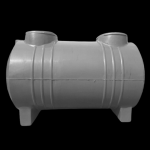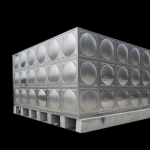Which Should You Choose for a Chemical Plant: FRP or HDPE Chemical Storage Tanks?
In today’s chemical plants, selecting the right chemical storage tank directly impacts operational safety, equipment lifespan, and maintenance costs. The two most common options are HDPE plastic tanks and FRP composite tanks. So which one is more optimal? This article will provide a detailed comparison to help you choose the best solution for your specific needs.
1. Overview of the Two Materials: FRP and HDPE

1.1. FRP – Fiberglass Reinforced Plastic
-
Composite of resin (Polyester or Vinyl Ester) reinforced with fiberglass
-
Excellent mechanical strength, corrosion, and chemical resistance
-
Long service life – up to 20 years
1.2. HDPE – High Density Polyethylene
-
High-density thermoplastic polymer
-
Good resistance to mild acids and weak bases
-
Easy to fabricate, lower cost, but less heat and pressure resistance than FRP
2. Comparison Criteria: FRP vs. HDPE Chemical Storage Tanks
| Criteria | FRP Composite Tank | HDPE Plastic Tank |
| Resistance to strong chemicals (H₂SO₄…) | Excellent with Vinyl Ester resin | Only suitable for diluted acids |
| Heat resistance | Up to 100–120°C | Up to 60–70°C |
| Mechanical strength | High, good pressure resistance | Moderate, prone to deformation |
| Design flexibility | Highly customizable | Limited |
| Long-term outdoor installation | Good if UV-protected | Ages quickly, prone to cracking |
| Lifespan | 15–20 years | 5–10 years |
| Cost | 20–30% higher | More affordable |
3. When to Choose FRP Composite Tanks

-
Storing highly corrosive chemicals like concentrated sulfuric acid (H₂SO₄), nitric acid (HNO₃), or sodium hydroxide (NaOH)
-
Operating under high temperatures (>above 70°C)
-
Tanks are installed outdoors and exposed to harsh weather
-
You need long-lasting equipment with minimal maintenance
-
You’re running a mid- to large-scale chemical plant requiring absolute safety
4. When HDPE Tanks Can Be Used
-
Storing mild, non-corrosive chemicals such as diluted acids, salts, and industrial wastewater
-
Applications with small capacity requirements and low pressure
-
Projects with low investment budgets, short-term use (3–5 years)
-
Indoor use or areas with protective roofing – not suitable for long-term outdoor exposure
5. Storing H₂SO₄ – FRP or HDPE?
Given the highly corrosive nature and strong reactivity of sulfuric acid (H₂SO₄), especially at concentrations of> 70%, HDPE tanks are not safe enough.
Why FRP composite tanks are the better choice for H₂SO₄:
-
Specialized Vinyl Ester liner provides excellent corrosion resistance
-
Superior heat resistance – does not warp under exothermic acid reactions
-
Sealed structure ensures long-term safety
-
Certified to meet technical standards: ASTM, ISO, BS4994, etc.
Conclusion: For sulfuric acid, HDPE is only suitable for very low concentrations and closed environments. In contrast, FRP composite tanks are a much safer and more durable option.
6. Key Considerations When Choosing a Chemical Storage Tank

-
Identify the exact type and concentration of chemicals in use
-
Choose the appropriate material: FRP with Vinyl Ester for strong acids, HDPE for milder substances
-
Prioritize suppliers with technical certifications and detailed engineering drawings
-
Require UV protection if the tank will be installed outdoors
-
Schedule regular maintenance to inspect valves, liners, and joints
-
ATNewtech – Leading FRP Composite Tank Manufacturer
7. ATNewtech – Leading FRP Composite Tank Manufacturer

A trusted brand in the composite chemical tank industry, ATNewtech specializes in:
-
Acid tanks and industrial H₂SO₄ storage tanks
-
FRP composite tanks in volumes from 500L to 50,000L
-
Custom design and installation per project requirements
-
Free consultation to select the right material
-
Nationwide delivery – Up to 3-year warranty
📞 Technical Support Hotline: 0834473166
🌐 Website: https://atnewtech.vn
8. Which Type of Tank is Best for a Chemical Plant?
| Need | Best Choice |
| Storing highly corrosive chemicals | FRP Composite Tank |
| Storing mild chemicals or solutions | HDPE Tank |
| Outdoor installation, harsh weather | FRP with UV protection |
| Low budget, short-term solution | HDPE Tank |
| Stable operation for 10–20 years | FRP Composite Tank |
Conclusion: For chemical plants, choosing the right type of chemical storage tank is a long-term investment in safety and efficiency. Let ATNewtech support you in selecting the most suitable solution.

 Composite Tank
Composite Tank Water tank cover.
Water tank cover. Kitchen equipment
Kitchen equipment Industrial water tank
Industrial water tank


